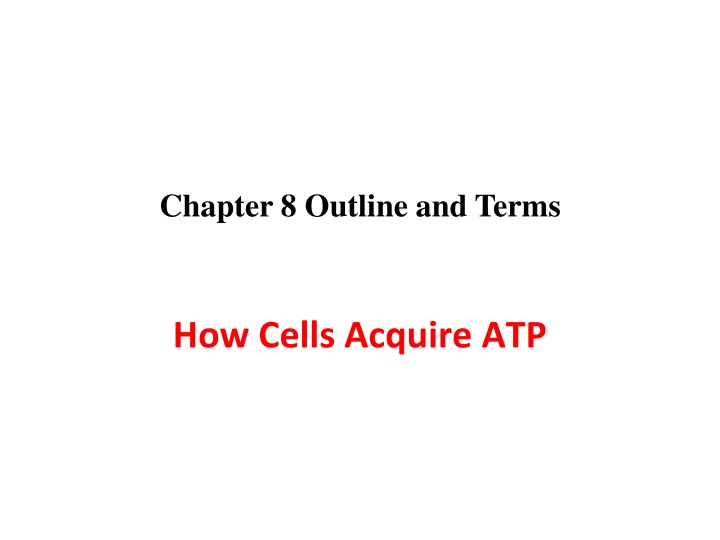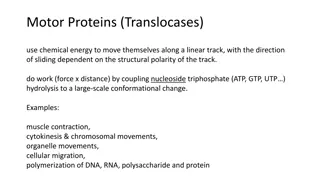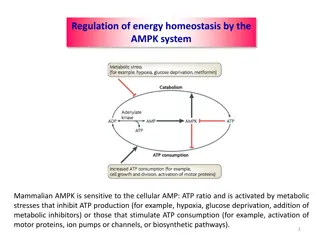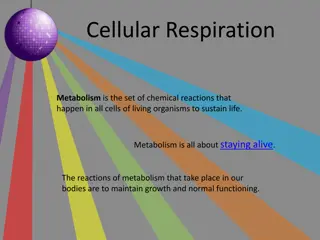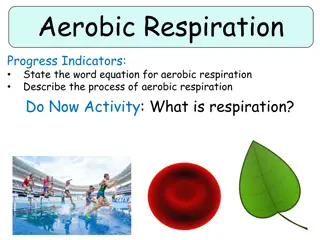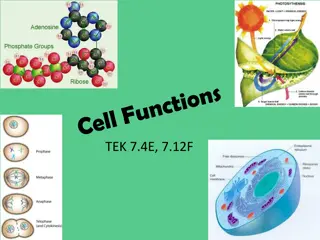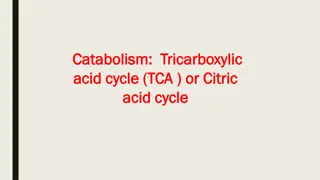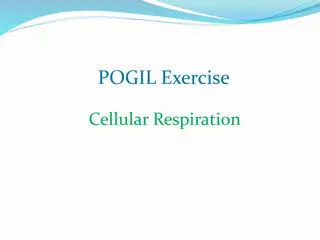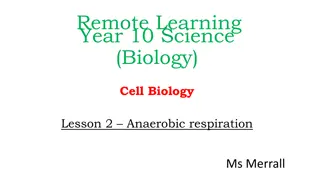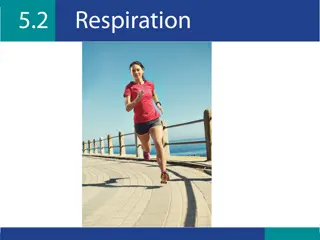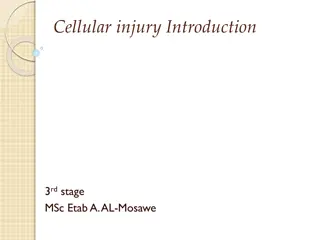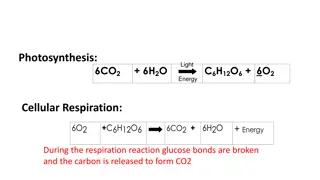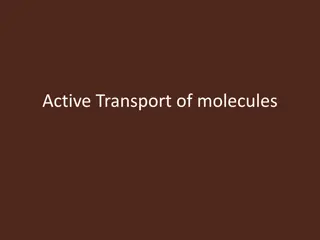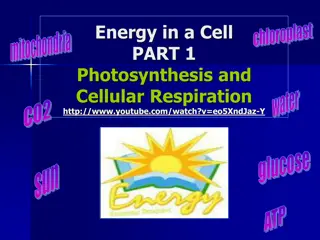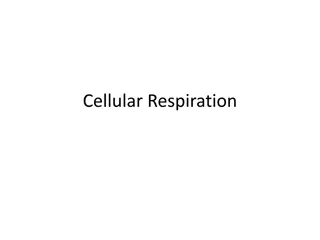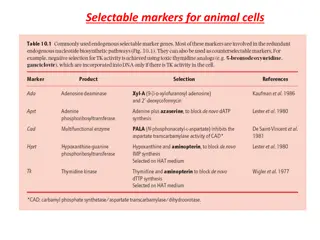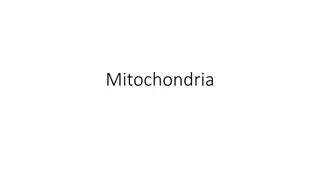How Cells Acquire ATP: Cellular Respiration Overview
Overview of cellular respiration focusing on how cells acquire ATP through metabolic pathways like glycolysis, the Krebs cycle, and the electron transport system. Details on the breakdown of glucose, energy production, and the role of NAD+ as an electron carrier are included.
Download Presentation

Please find below an Image/Link to download the presentation.
The content on the website is provided AS IS for your information and personal use only. It may not be sold, licensed, or shared on other websites without obtaining consent from the author.If you encounter any issues during the download, it is possible that the publisher has removed the file from their server.
You are allowed to download the files provided on this website for personal or commercial use, subject to the condition that they are used lawfully. All files are the property of their respective owners.
The content on the website is provided AS IS for your information and personal use only. It may not be sold, licensed, or shared on other websites without obtaining consent from the author.
E N D
Presentation Transcript
Chapter 8 Outline and Terms How Cells Acquire ATP
A. Cellular Respiration: 1. Cellular respiration includes the various metabolic pathways that break down carbohydrates and other metabolites and build up ATP. . 2. Aerobic respiration begins with glucose and ends with CO2 and H2O. 3. Overall equation for complete breakdown of glucose requires oxygen (is aerobic): C6H12O6 + 6 O2 6 CO2 + 6 H2O + energy 4. Glucose is high-energy molecule; CO2 and H2O are low- energy molecules; process is exergonic and releases energy. 5. Electrons are removed from substrates and received by oxygen, combines with H+ to become water. 6. Glucose is oxidized and O2 is reduced.
7. Buildup of ATP is an endergonic reaction that requires energy. 8. Pathways of aerobic respiration allow energy in glucose to be released slowly; ATP is produced gradually. 9. Rapid breakdown of glucose would lose most energy as nonusable heat. 10. Breakdown of glucose yields synthesis of 36 ATP; this preserves 40% of energy available in glucose
B. NAD+ Is a Carrier of Electron: 1. Each metabolic reaction in cellular respiration is catalyzed by its own enzyme. 2. As a metabolite is oxidized, NAD+ accepts two electrons and a hydrogen ion (H+); results in NADH + H+. 3. Electrons received by NAD+ and FAD are high-energy electrons and are carried to the electron transport system. 4. NAD+ is a coenzyme of oxidation-reduction since it both accepts and gives up electrons. 5. Only a small amount of NAD+ is needed in cells; each NAD+ molecule is used over and over. 6. FAD coenzyme of oxidation-reduction can replace NAD+; FAD accepts two electrons, becomes FADH2.
C. Metabolic Pathways Are Required : 1. Aerobic respiration includes metabolic pathways and one individual reaction: a. Glycolysis is the breakdown of glucose to two molecules of pyruvate. 1) Enough energy is released for immediate buildup of two ATP. 2) Glycolysis takes place outside the mitochondria and does not utilize oxygen. b. The transition reaction: pyruvate is oxidized to an acetyl group and CO2 is removed. c. The Krebs cycle 1) This series of reactions gives off CO2 and produces ATP. 2) Produces two immediate ATP molecules per glucose molecule. d. The electron transport system 1) Series of carriers accepts electrons from glucose; electrons are passed from carrier to carrier until received by oxygen. 2) Electrons pass from higher to lower energy states, energy is released and stored for ATP production. 2. Pyruvate is a pivotal metabolite in cellular respiration. a. If O2 is not available to the cell, fermentation, an anaerobic process, occurs. b. During fermentation, glucose is incompletely metabolized to lactate or CO2 and alcohol. c. Fermentation results in a net gain of only two ATP per glucose molecule.
Outside the Mitochondria: Glycolysis : A. Glycolysis: 1. Occurs in the cytosol outside the mitochondria. 2. Is the breakdown of glucose to two pyruvate molecules. 3. Is universal in organisms; therefore, most likely evolved before Krebs cycle and electron transport system. B. Energy Investment Steps: 1. Glycolysis begins with addition of two phosphate groups, activating glucose to react. 2. Two separate reactions use two ATP. 3. Glucose, a C6 molecule, splits into two C3 molecules, each with a phosphate group.
C. Energy Harvesting Steps: 1. Two electrons and one hydrogen ion are accepted by NAD+ and result in two NADH. 2. Enough energy is released from breakdown of glucose to generate four ATP molecules. 3. Two of four ATP molecules produced are required to replace two ATP molecules used in the phosphorylation of glucose. . 4. There is a net gain of two ATP from glycolysis. 5. If aerobic respiration follows glycolysis, pyruvate enters mitochondria. 6. Glycolysis can also be followed by fermentation.
Inside the Mitochondria: Completion of Aerobic Respiration : A. Aerobic Respiration: 1. Involves the transition reaction, the Krebs cycle, and the electron transport system. 2. Is process in which pyruvate from glycolysis( out side mitochondria ) is broken down completely(inside mitochondria ) to CO2 and H2O. 3. Takes place inside mitochondria. .
B. Mitochondria are the site of most cellular respiration. 1. Mitochondria has double membrane with an intermembrane space between outer and inner membrane. 2. Cristae are the inner folds of membrane that just out into matrix. 3. Matrix is the innermost compartment of a mitochondria and is filled with gel-like fluid. 4. Transition reaction and Krebs cycle enzymes are in matrix; electron transport system is in cristae. 5. Most ATP produced in cellular respiration is produced in mitochondria.
C. Transition Reaction Releases CO2 1. Transition reaction connects glycolysis to the Krebs cycle. 2. In this reaction, pyruvate is converted to a two-carbon acetyl group attached to coenzyme A. 3. This oxidation reaction removes electrons from pyruvate by dehydrogenase using NAD+ as coenzyme. 4. Reaction occurs twice for each original glucose molecule.
D. The Krebs Cycle Finishes Glucose Breakdown : 1. Krebs cycle reactions occur in matrix of mitochondria. 2. Cycle is named for Sir Hans Krebs, who received Nobel Prize for identifying these reactions. 3. Cycle begins by adding C2 acetyl group to C4 molecule, forming citrate; also called the citric acid cycle. 4. The acetyl group is then oxidized to two molecules of CO2. 5. During the oxidation process, most electrons (e) are accepted by NAD+ to form NADH. 6. In one instance, electrons are taken by FAD, which becomes FADH2. 7. NADH and FADH2 carry these electrons to electron transport system. 8. Some energy released is used to synthesize ATP by substrate-level phosphorylation, as in glycolysis. 9. One high-energy metabolite accepts a phosphate group and passes it on to convert ADP to ATP. 10. Krebs cycle turns twice for each original glucose molecule. 11. Products of the Krebs cycle per glucose molecule include 4 CO2, 2 ATP, 6 NADH and 2 FADH2
E. The Electron Transport System Produces Most ATP: 1. Electron transport system is located in cristae of mitochondria; consists of carriers that pass electrons. 2. Some protein carriers are cytochrome molecules. 3. Electrons that enter the electron transport system are carried by NADH and FADH2. 4. NADH gives up its electrons and becomes NAD+; next carrier gains electrons and is reduced. 5. At each sequential oxidation-reduction reaction, energy is released to form ATP molecules. 6. Oxygen serves as terminal electron acceptor and combines with hydrogen ions to form water. 7. Because O2 must be present for system to work, it is also called oxidative phosphorylation. 8. NADH delivers electrons to system; by the time electrons are received by O2, three ATP are formed. 9. If FADH2 delivers electrons to system, by the time electrons are received by O2, two ATP are formed. 10. Coenzymes and ATP recycle a. Cell needs a limited supply of coenzymes NAD+ and FAD because they constantly recycle.
F. The Cristae Are Organized : 1. Electron transport system consists of three protein complexes and two protein mobile carriers that transport electrons between complexes. . 2. Energy released from flow of electrons down electron transport chain is used to pump H+ ions, carried by NADH and FADH2, into intermembrane space (crista). 3. Accumulation of H+ ions in this intermembrane space 4. ATP synthase complexes are channel proteins that also serve as enzymes for ATP synthesis. 5. As H+ ions flow from high to low concentration, ATP synthase synthesizes ATP; actual mechanism is still unknown. 6. "Chemiosmosis" is term used since ATP production tied to electrochemical gradient across a membrane. 7. Once formed, ATP molecules diffuse out of the mitochondrial matrix through channel proteins.
G. Calculating the Energy Yield From Glucose Metabolism : 1. Substrate-Level Phosphorylation: Small Yield a. Per glucose molecule, there is a net gain of two ATP from glycolysis in cytosol. b. The Krebs cycle in the matrix of the mitochondria produces two ATP per glucose. c. Total of four ATP are formed outside of the electron transport system. 2. Oxidative Phosphorylation: Great Yield a. Most ATP is produced by the electron transport system. b. Per glucose, 10 NADH and two FADH2 molecules provide electrons and H+ ions to electron transport system. c. For each NADH formed within the mitochondrion, three ATP are produced.
Metabolic Pool and Biosynthesis : A. Reactions Can be Degradative or Synthetic. 1. Degradative reactions participate in catabolism and break down molecules; they tend to be exergonic. 2. Synthetic reactions participate in anabolism and build molecules; they tend to be endergonic. B. Catabolism: Breaking Down : 1. Just as glucose was broken down in cellular respiration, other molecules undergo catabolism. 2. Fat breaks down into glycerol and three fatty acids. a. Glycerol is converted to PGAL, a metabolite in glycolysis. b. An 18-carbon fatty acid is converted to nine acetyl-CoA molecules that enter the Krebs cycle. c. Respiration of fat products can produce 109 ATP molecules; fats are efficient form of stored energy. 3. Amino acids break down into carbon chains and amino groups. a. Hydrolysis of proteins results in amino acids. b. R-group size determines whether carbon chain is oxidized in glycolysis or the Krebs cycle.
C. Anabolism: Building Up 1. ATP produced during catabolism drives anabolism. 2. Substrates making up pathways can be used as starting materials for synthetic reactions. 3. Molecules used for biosynthesis constitute metabolic pool. 4. Carbohydrates can result in fat synthesis: PGAL converts to glycerol, acetyl groups join to form fatty acids. 5. Some metabolites can be converted to amino acids by transamination, transfer of an amino acid group to an organic acid. 6. Plants synthesize all amino acids they need; animals lack some enzymes needed to make some amino acids. 7. Humans synthesize 11 of 20 amino acids; remaining 9 essential amino acids must be provided by diet.
Fermentation : A. Cellular Respiration Includes Fermentation 1. Fermentation consists of glycolysis plus reduction of pyruvate to either lactate or alcohol and CO2. 2. NADH passes its electrons to pyruvate instead of to an electron transport system; NAD+ is then free to return and pick up more electrons during earlier reactions of glycolysis. 3. Examples : a. Anaerobic bacteria produce lactic acid when we manufacture some cheeses. b. Anaerobic bacteria produce industrial chemicals: isopropanol, butyric acid, propionic acid, and acetic acid. c. Yeasts use CO2 to make bread rise, produce alcohol in winemaking. d. Animals reduce pyruvate to lactate when it is produced faster than it can be oxidized by Krebs cycle.
B. Advantages and Disadvantages of Fermentation 1. Despite low yield of two ATP molecules, fermentation provides quick burst of ATP energy for muscular activity. 2. Disadvantage is that lactate is toxic to cells. a. When blood cannot remove all lactate from muscles, lactate changes pH and causes muscles to fatigue. b. Individual is in oxygen debt because oxygen is still needed after exercising. c. Recovery occurs after lactate is sent to liver, converted into pyruvate; then respired or converted into glucose.
C. How Efficient Is Fermentation? 1. Two ATP produced per glucose molecule during fermentation is equivalent to 14.6 kcal. 2. Complete glucose breakdown to CO2 and H2O during cellular respiration results in 686 kcal. of energy. 3. Efficiency for fermentation is 14.6/686 or about 2.1%; much less than complete breakdown of glucose.
C. Microscopy of Today 1. Bright-field microscope uses light rays focused by glass lenses. 2. Transmission electron microscope (TEM) uses electrons passing through specimen; focused by magnets. 3. Scanning electron microscope (SEM) uses electrons scanned across metal-coated specimen. 4. Magnification is function of wavelengths; shorter wavelengths of electrons allow greater magnification. 5. Resolution is minimum distance between two objects before they are seen as one larger object. 6. Immunofluorescence microscopy uses fluorescent antibodies to reveal proteins in cells. 7. Confocal microscopy uses laser beam to focus on shallow plane; forms series of optical sections.
4.2. Prokaryotic Cells Are Less Complex (p. 62) B. Bacteria Are prokaryotic Cells 1. Bacteria belong to the kingdom Monera. 2. Most are between 1-10 m in diameter, just visible with light microscopes. 3. Structures: [transp. 20] a. Cell wall is composed of peptidoglycan. b. Bacteria may be surrounded by a capsule and/or gelatinous sheath called a slime layer. c. Motile bacteria usually have flagella, which rotate like propellers to move through fluid medium. d. Fimbriae are short appendages that help them attach to an appropriate surface. e. Plasma membrane is the outermost membrane; regulates the entrance and exit of molecules. f. Cytoplasm consists of cytosol, a semifluid medium. g. Ribosomes are granular inclusions that coordinate synthesis of proteins. h. Nucleoid contains most genes in a circular DNA molecule. i. Plasmids are small accessory rings of DNA aside from the nucleoid. j. Thylakoids are flattened discs with light-sensitive pigment molecules.
4.3. Eukaryotic Cells Are More Complex (p. 63) A. Eukaryotic Cells : 1. Include cells of organisms belonging to kingdoms other than Monera. 2. Membrane-bounded nucleus houses DNA in threadlike structures called chromatin. 3. Most are between 10-100 m in diameter, or ten to 100 times larger than prokaryotic cells. 4. Similar to prokaryotic cells, eukaryotic cells have a plasma membrane and cytoplasm including ribosomes. 5. Eukaryotic cells are more complex than prokaryotic cells, have organelles, including a true nucleus, and an organised lattice of protein filaments called the cytoskeleton.
B. Nucleus Stores Genetic Information 1. Stores genetic information determining structure/function of cells by regulating sequences of amino acids. 2. Structures (Fig. 4.6) [transp. 23] a. Nucleus has a diameter of about 5 m. b. Chromatin is a threadlike material that coils into chromosomes just before cell division occurs; contains DNA, protein, and some RNA. c. Chromosomes are rod-like structures formed during cell division; coiled or folded chromatin. d. Nucleoplasm is semifluid medium of nucleus; has a different pH from cytosol. e. Nucleoli are dark-staining spherical bodies in nucleus; sites where rRNAjoins proteins to form ribosomes. f. Nuclear envelope is a double membrane that separates nucleoplasm from cytoplasm. g. Nuclear pores (100 nm) permit passage of proteins into nucleus and ribosomal subunits.
C. Ribosomes Are Sites of Protein Synthesis 1. Ribosomes of eukaryotic cells are 20 nm - 30 nm; those of prokaryotic cells are slightly smaller. 2. Ribosomes are composed of a large and a small subunit. 3. Each subunit has its own mix of proteins and rRNA. 4. Ribosomes coordinate assembly of amino acids into polypeptide chains (i.e., protein synthesis). 5. Polyribosomes are several ribosomes synthesizing same protein; may be attached to ER or may lie free.
